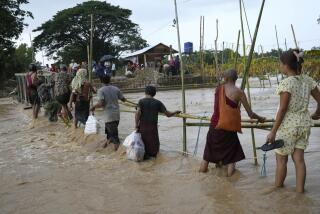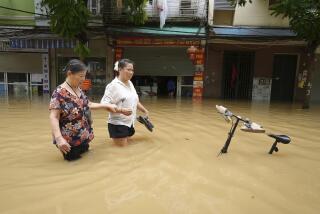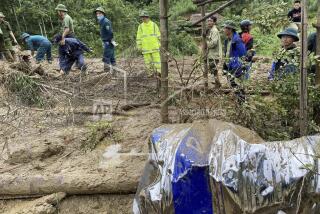Families in the Philippines coordinate their own relief efforts
ORMOC, Philippines — Dressed in shorts and a pink T-shirt, Dimples Juntilla was headed Friday to a village named Friendly, embarking on a mission of mercy in the wake of Typhoon Haiyan.
Arriving by ferry from the relatively unscathed port of Cebu, Juntilla, a bank employee, bore boxes of biscuits, noodles, candles, medicine and toiletries, all to assist relatives in Friendly, just outside Ormoc.
Her heart had sunk when she was told back in Cebu that the ferry was overloaded and the wares would have to be left behind. “We badly need them,” Juntilla, 22, pleaded. “Not just me, but my family and neighbors.”
PHOTOS: Typhoon Haiyan slams Philippines
Her persistence paid off. The crew allowed her to load the precious cargo, some of it purchased with donations from relatives in Canada. Aboard the ferry, similar boxes were stacked up against walls and in the aisles. It seemed that everyone on the packed ferry Friday morning was taking much-needed supplies to their families.
Even as thousands of Filipinos continue to flee the disaster zone a week after Typhoon Haiyan hit, others are looking for ways back to search for missing loved ones and to take in supplies.
In Cebu, lines form before dawn each day for ferry tickets or elusive seats on military aid flights back to the hard-hit neighboring island of Leyte.
With a United Nations agency now putting the death toll at 4,460, the Philippine government is under fire for what critics say is the slow pace of its official relief effort.
“In a situation like this, nothing is fast enough,” Interior Secretary Max Rosas told reporters during a visit to Tacloban, the provincial capital of Leyte that was largely destroyed by the Nov. 8 typhoon. “The need is massive, the need is immediate, and you can’t reach everyone.”
As a result, relatives of the newly homeless are pitching in, purchasing supplies and seeking to deliver them however possible.
At the air base in Cebu, Hermenia Tibayan sat on a patch of grass watching planes loaded with supplies from around the world take off for Tacloban. Tibayan, 40, lives with her husband in Manila, the capital. But the rest of the family — her father, brother, sister and a niece — were in Tacloban when the typhoon hit.
“I don’t know if they are still alive, but I hope,” she said, her voice trailing away.
With news of bodies lining the streets and a city bereft of food, water, power and communications filling headlines, Tibayan filled a backpack with biscuits, sardines, water, medicine, candles and water purification tablets.
It took four days to find a seat on a commercial flight to Cebu. From there, she hoped to get onto an aid flight to Tacloban. She arrived at the air field at 4 a.m Thursday and was still waiting at 5 p.m. that day as flights were winding down.
“I will stay and try tomorrow,” she said.
Lt. Col. Marciano Jesus Guevara, spokesman for the Philippine air force’s 2nd Air Division, said he was sympathetic but authorities have to prioritize relief supplies and don’t want more civilians in the disaster zone.
“There is no sense going there,” he said. “There is no transportation, so the next thing will be, ‘Please take us out.’”
Juntilla had already caught a ferry home from Cebu earlier in the week after being unable to reach her father by phone. She knew he had been dispatched by an electric company to a town outside Tacloban and feared the worst.
Her first sight of Ormoc was staggering: entire buildings collapsed, rows of electricity pylons knocked down, a street once lined with houses reduced to a debris-strewn wasteland.
But there, among the frantic crowds, stood her father. He had survived the storm and walked nearly 13 hours to get home. “We embraced and thanked the Lord,” she said.
She returned to Cebu two days later, and with the help of other family members, reached out to their North American relatives for contributions.
“I don’t want to blame the government, but it is so disheartening that it took our president five days to get relief to us, when there is so much food from so many countries already,” she said. “They say it is difficult to travel, but why are we able to and they are not?”
Sitting nearby on the ferry was Pagunsan Villafranca, 62, who had been dispatched by his employer to look for the man’s elderly aunt. With communications and electricity down in many areas, it had been impossible to reach her. He pulled out a sheet of paper with carefully written directions to the woman’s house.
“That’s near my street,” said a passenger on the ferry, Rafaela Rojas, 37. “I’ll show you.”
Rojas had just dropped off her 13-year-old son with an aunt in Cebu and was returning with supplies for the rest of the family. Her husband works in Australia, so she was alone with her son when the super typhoon whipped through Ormoc. The storm ripped off their roof, shattered the windows and tossed around their possessions. They clutched their terrified dog and prayed.
In Ormoc on Friday, the port was overflowing with refugees, the dock crammed with people and luggage. Juntilla’s relatives were waiting for her. Together they loaded her boxes onto a three-wheeled motorcycle and took off.
Just beyond the gates, water gushed from a fire hydrant. A small crowd had formed to scrub clothes, bathe and fill jerrycans. Others gathered in a nearby square to recharge flashlights and cellphone batteries using a generator provided by a local cellphone company.
Around the corner, a long line had formed outside Mercury Drug pharmacy. Jennifer Sampaga, 47, arrived at 2 p.m. and was still waiting when the store closed its doors three hours later. She said her gallstone medicine ran out that morning and she did not know where else to go.
“Medicine is hard to find here,” she said, as she climbed on the back of her husband’s motorbike, still clutching the prescription.
The line of motorcycles outside a nearby gas station stretched around the block. A painted sign hung on the front of a house: “President Obama please help me and all the people of Ormoc.”
Just outside the city, the Juntillas turned down a rutted lane, past rows of roofless homes, collapsed fences and stacks of debris. Some families now sleep under makeshift tents. Many had relocated to Friendly village after losing their homes to a deadly storm in 1991. But the flimsy construction materials they used were no match for last week’s typhoon, known here as Yolanda.
The sturdy concrete home of Juntilla’s father was the only one still intact. Since the storm, five families have crammed into its three rooms and spilled onto the porch. There are so many people that dinner has to be served in shifts around a small round table. But the simple meal of boiled rice and spicy tuna is a joyful affair.
Like many in this deeply Roman Catholic country, family members have turned to their faith to see them through.
“We always believe there will be a rainbow after the rain,” Juntilla said. She laughed and added, “Maybe the houses were destroyed because the Lord wants us to build mansions.”
Times staff writer Barbara Demick in Beijing contributed to this report.
More to Read
Sign up for Essential California
The most important California stories and recommendations in your inbox every morning.
You may occasionally receive promotional content from the Los Angeles Times.










